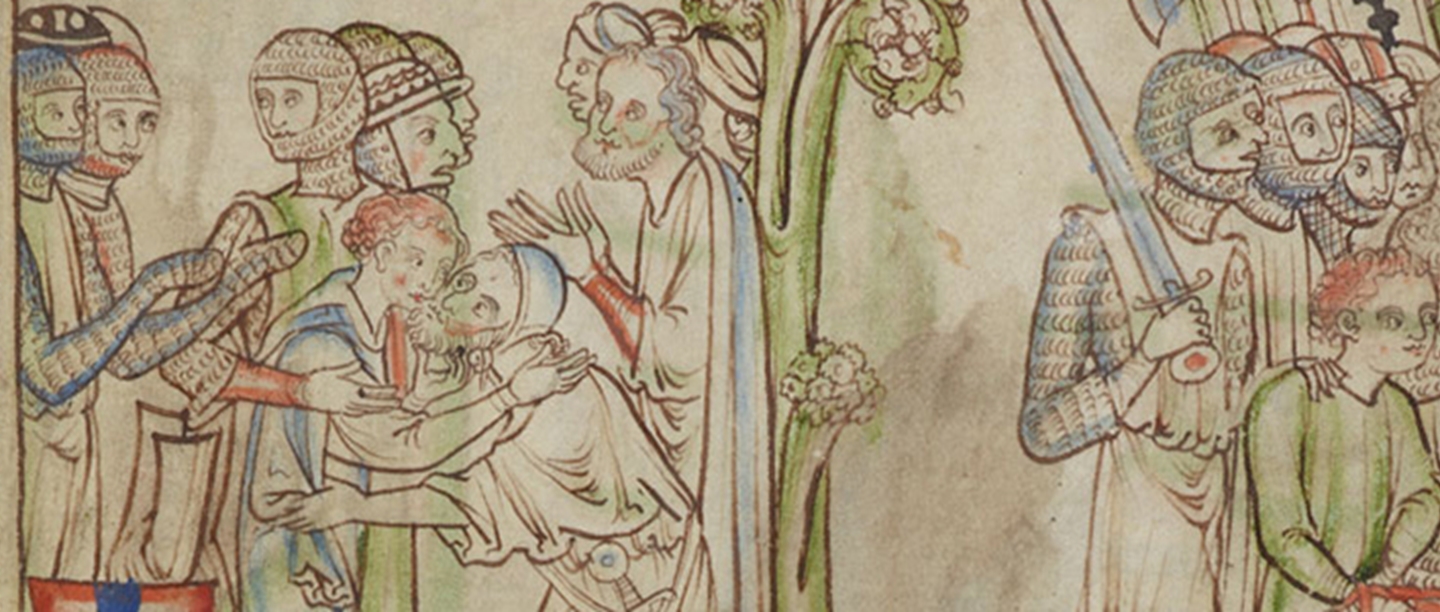
People have always told stories about the past to help them understand the present. During the medieval period poems, songs and even Saints’ Lives gave the public a window onto past events in the way a Hollywood movie ‘based on a true story’ can today.
Just like a film, these accounts could be exaggerated and inaccurate – but they give us an insight into how medieval people saw their own past.
It is often said that history is written by the winners, and with the Norman Conquest the earliest chronicle accounts do indeed have a Norman bias. However, the dramatic backdrop of invasion made it easy to turn men into heroes or villains and, as you will see, in the popular-reputation battle the Normans didn’t always come out on top!
Here are three examples of medieval stories told about the events of 1066 and its aftermath:
Story #1: King Harold didn’t die!
Let’s start with the big one. Far from being hit in the eye by an arrow, or even cut to pieces as most early accounts describe, the early thirteenth-century Vita Haroldi claims that King Harold survived the Battle of Hastings.
In the Vita, Harold was found wounded but alive on the battlefield. Having recovered he spent several years travelling around Europe before returning to England and ending his life quietly as a hermit, only revealing his identity on his death bed.
Detail from the Bayeux Tapestry depicting Harold’s coronation. CC BY-SA 2.0 via Wikimedia Commons
The author is aware his account differs from most others but insists he is not writing fiction, criticising other chroniclers for believing what they are told rather than seeking out the truth. He claims the rumours of Harold’s death were started as an attempt to protect the king while he was recovering from his wounds.
The Vita is a completely pro-Harold depiction of the Conquest. It defends him against Norman accusations that he had usurped William’s throne, and uses his later life to depict him almost as a saint. Harold turns away from the search for worldly power through violence, seeking a spiritual warfare with heaven as its reward. An example that the author clearly hoped his readers would emulate.
If you are interested in reading the whole story you can find it here.
Story #2: Normans were a problem even before the Conquest
As noted in a previous blog post, Queen Edith commissioned an account of Edward the Confessor’s life, the Vita Edwardi Regis, which showed him as a saint while simultaneously defending her own family’s reputation.
Earl Godwin embracing Edward’s brother Alured – from a C13th century version of the Life of King Edward owned by Cambridge University. A digital facsimile of the whole manuscript is available here. (Note: this is not the same version of Edward’s life as I discuss in this post but a later one which does not include the episode I mention.)
In the Vita Edwardi, her father, Godwin of Wessex’s, embarrassing exile for treachery is explained away as the fault of an unscrupulous Norman courtier, Robert of Jumieges. There was personal conflict between Robert and Earl Godwin but Robert had the king’s favour. He was able to turn the king against the Earl, having Godwin sent into exile without trial
In the immediately post-conquest context in which Edith was living, it is interesting the extent to which Godwin’s Englishness is emphasised and one of Edward’s Norman supporters is vilified. Godwin is a symbol of the English nation. The people saw his exile ‘to be their own ruin, the destruction of the English people, indeed, the downfall of the whole land’.
By contrast Robert is depicted as entirely unreasonable, drunk on power and ‘driven by his madness’.
Story #3: Heroic Saxon Resistance
Historically there was resistance against William for several months around Ely Cathedral. One of those involved was Hereward the Wake.
A biography from the thirteenth century (apparently based on an earlier Anglo-Saxon work drawn from accounts by friends of Hereward) describes the events at Ely as part of a broader attempt to depict him as a hero. Other parts of the story include rescuing princesses and overcoming impossible odds single handed.
Hereward fighting Normans, illustration from Cassell’s History of England (1865) | By John Cassell (Internet Archive) [Public domain], via Wikimedia Commons
While fighting the Normans, Hereward used trickery and disguise to outwit his opponents. For example, he disguised himself as a potter to infiltrate the king’s court as a spy and was able to overhear plans of attack. He also disguised himself as a fisherman, following the king’s orders to help move equipment for the army but setting fire to it all before he left.
Other members of the resistance included Sir Brunman, who dunked French monks in the sea, and an ineffective witch who mooned the Norman army before falling and breaking her neck.
Hereward’s biography depicts the events at Ely as a story of English resistance to oppression. Their main objection is the proposal to bring in French monks to lead English religious houses, ignoring the fact that there was strong Danish involvement historically.
This is also one of the earliest examples of an outlaw story, a genre that came to fruition with Robin Hood.
Find out more about the Norman Conquest and its aftermath
Stories aside, it’s undeniable that the overthrow of the Saxon kingdom of England by William the Conqueror and his Norman knights had a huge impact on the country. From how it was organised and governed to its language and customs, after 1066 England was transformed. Perhaps the most visibly legacy today, is Norman architecture.
Read more about the impact of the Norman Conquest on the English Heritage website.